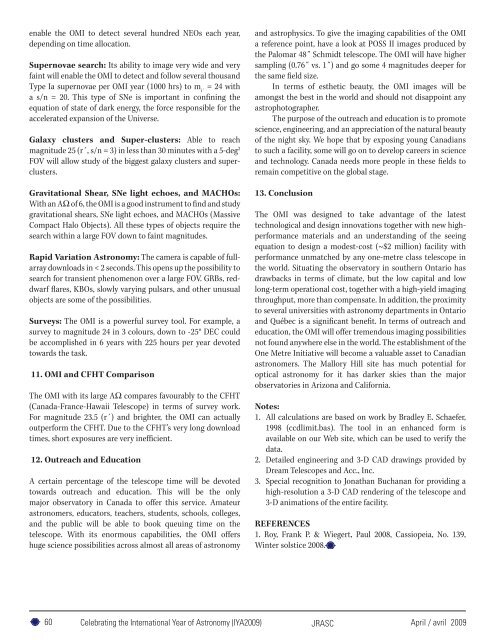Moment
insidethisissue - The Royal Astronomical Society of Canada
insidethisissue - The Royal Astronomical Society of Canada
You also want an ePaper? Increase the reach of your titles
YUMPU automatically turns print PDFs into web optimized ePapers that Google loves.
enable the OMI to detect several hundred NEOs each year,depending on time allocation.Supernovae search: Its ability to image very wide and veryfaint will enable the OMI to detect and follow several thousandType Ia supernovae per OMI year (1000 hrs) to m i´= 24 witha s/n = 20. This type of SNe is important in confining theequation of state of dark energy, the force responsible for theaccelerated expansion of the Universe.Galaxy clusters and Super-clusters: Able to reachmagnitude 25 (r´, s/n = 3) in less than 30 minutes with a 5-deg 2FOV will allow study of the biggest galaxy clusters and superclusters.Gravitational Shear, SNe light echoes, and MACHOs:With an AΩ of 6, the OMI is a good instrument to find and studygravitational shears, SNe light echoes, and MACHOs (MassiveCompact Halo Objects). All these types of objects require thesearch within a large FOV down to faint magnitudes.Rapid Variation Astronomy: The camera is capable of fullarraydownloads in < 2 seconds. This opens up the possibility tosearch for transient phenomenon over a large FOV. GRBs, reddwarfflares, KBOs, slowly varying pulsars, and other unusualobjects are some of the possibilities.Surveys: The OMI is a powerful survey tool. For example, asurvey to magnitude 24 in 3 colours, down to -25° DEC couldbe accomplished in 6 years with 225 hours per year devotedtowards the task.11. OMI and CFHT ComparisonThe OMI with its large AΩ compares favourably to the CFHT(Canada-France-Hawaii Telescope) in terms of survey work.For magnitude 23.5 (r´) and brighter, the OMI can actuallyoutperform the CFHT. Due to the CFHT’s very long downloadtimes, short exposures are very inefficient.12. Outreach and EducationA certain percentage of the telescope time will be devotedtowards outreach and education. This will be the onlymajor observatory in Canada to offer this service. Amateurastronomers, educators, teachers, students, schools, colleges,and the public will be able to book queuing time on thetelescope. With its enormous capabilities, the OMI offershuge science possibilities across almost all areas of astronomyand astrophysics. To give the imaging capabilities of the OMIa reference point, have a look at POSS II images produced bythe Palomar 48˝ Schmidt telescope. The OMI will have highersampling (0.76˝ vs. 1˝) and go some 4 magnitudes deeper forthe same field size.In terms of esthetic beauty, the OMI images will beamongst the best in the world and should not disappoint anyastrophotographer.The purpose of the outreach and education is to promotescience, engineering, and an appreciation of the natural beautyof the night sky. We hope that by exposing young Canadiansto such a facility, some will go on to develop careers in scienceand technology. Canada needs more people in these fields toremain competitive on the global stage.13. ConclusionThe OMI was designed to take advantage of the latesttechnological and design innovations together with new highperformancematerials and an understanding of the seeingequation to design a modest-cost (~$2 million) facility withperformance unmatched by any one-metre class telescope inthe world. Situating the observatory in southern Ontario hasdrawbacks in terms of climate, but the low capital and lowlong-term operational cost, together with a high-yield imagingthroughput, more than compensate. In addition, the proximityto several universities with astronomy departments in Ontarioand Québec is a significant benefit. In terms of outreach andeducation, the OMI will offer tremendous imaging possibilitiesnot found anywhere else in the world. The establishment of theOne Metre Initiative will become a valuable asset to Canadianastronomers. The Mallory Hill site has much potential foroptical astronomy for it has darker skies than the majorobservatories in Arizona and California.Notes:1. All calculations are based on work by Bradley E. Schaefer,1998 (ccdlimit.bas). The tool in an enhanced form isavailable on our Web site, which can be used to verify thedata.2. Detailed engineering and 3-D CAD drawings provided byDream Telescopes and Acc., Inc.3. Special recognition to Jonathan Buchanan for providing ahigh-resolution a 3-D CAD rendering of the telescope and3-D animations of the entire facility.REFERENCES1. Roy, Frank P. & Wiegert, Paul 2008, Cassiopeia, No. 139,Winter solstice 2008.60 Celebrating the International Year of Astronomy (IYA2009)JRASC April / avril 2009
















